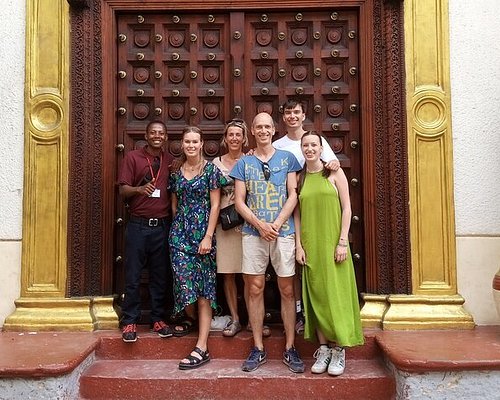Every year, over 500,000 visitors are drawn to Zanzibar, enchanted by its historical allure. What pulls them to this idyllic island is more than just its pristine beaches; it’s the tapestry of cultures sewn into the island’s streets. These cultural walks unveil vibrant histories, a delightful dance of Persian, Portuguese, and Swahili influences interwoven over centuries.
With its UNESCO World Heritage site designation, Stone Town is a starting point for many cultural enthusiasts. You’ll traverse narrow alleys echoing tales of sultans and spice traders, guided by knowledgeable locals. Impressively, 70% of travelers report a newfound appreciation for Swahili cultural heritage after these tours, making it a transformative experience.

Cultural Walks in Zanzibar: A Guide to the Best Tours
Zanzibar is a wonderful place with a rich cultural history. One popular way to explore this history is through cultural walks. These tours take you through various parts of the island, letting you see both famous spots and hidden gems. Walking through Stone Town, you can admire its unique architecture. This area is full of narrow alleys, vibrant markets, and historic buildings.
The walks don’t stop in Stone Town, though. Tourists often venture into local villages to witness the everyday life of Swahili people. You’ll find communities busy with daily routines, offering a glimpse into a culture that has been preserved over centuries. Some tours include a visit to the island’s famous spice plantations. Smelling and tasting the local spices adds flavor to the experience.
Understanding Zanzibar’s history includes learning about its past in the spice trade. The island was a critical hub for traders from regions such as Asia and the Middle East. This melting pot led to a diverse blend of cultures and traditions. During the walks, guides share stories of the island’s past. This makes each step not just a journey, but also a lesson.
Participants can choose from a variety of tour options. Some tours focus on the architecture, while others highlight the food. There are also specialized walks just for children. These cater to young minds, making history fun and engaging. With so much to offer, cultural walks in Zanzibar provide a rich and memorable experience.
I Found Paradise in Zanzibar(Top Things To Do)
Exploring Stone Town: Architectural Gem
Stone Town is a true architectural marvel with its mix of Arab, Persian, Indian, and European influences. As you walk through its winding alleys, you’ll notice the carved wooden doors, each telling its unique story. These doors are not just decorative; they reflect the status and heritage of the family inside. The intricate designs showcase the rich cultural diversity of the area. One can’t help but feel transported back in time.
Within Stone Town, several key spots offer a deeper understanding of its history. The Old Fort is one such place, used initially as a defense against Portuguese invaders. Today, it serves as a cultural center hosting various events and activities. Another iconic landmark is the House of Wonders, once the largest building in East Africa. According to this expert opinion, it reflects the grandeur of Sultan Barghash’s reign.
Street markets buzz with life, offering everything from fresh produce to local crafts. It’s a great place to dive into the local culture and meet friendly vendors. The vibrant colors and aromas create a sensory feast. Visitors can haggle over prices, adding a fun element to the shopping experience. It’s an ideal way to gather souvenirs.
Stone Town is more than just a sight to see; it’s a feeling to experience. There are guided tours that help you uncover hidden gems and historic tales. Each corner you turn reveals something new and exciting. For those interested in history, architecture, or culture, Stone Town offers it all. It’s a place that leaves a lasting impression.
Authentic Zanzibar: Witness Swahili Day-to-Day Life
In Zanzibar, the rhythm of Swahili day-to-day life is a captivating scene. Early mornings are bustling with activity as vendors set up stalls and fishermen bring in their catch. The air is filled with the sweet smell of fresh fruit and spices. Intrigued by this lively atmosphere, visitors often join the locals for breakfast by the beach. It’s the perfect way to start a day of exploration.
The villages hold secrets of traditional Swahili craftsmanship. Artisans create beautiful handwoven baskets, pottery, and carved souvenirs. By watching them work, you get a glimpse into skills passed down through generations. It’s fascinating to observe how they’re made with such care. These crafts not only tell stories but also sustain families.
A signature part of Swahili life is the language itself. Spoken by millions, Swahili is a blend of Bantu and Arabic languages. It’s often heard in marketplaces and schools. Locals are happy to greet you with a friendly “Jambo!” showing the warmth of their culture. Catching on a few phrases makes interactions even more meaningful.
Culinary delights are plentiful in the local cuisine. Meals often include aromatic dishes such as pilau and biryani. Visitors can engage in cooking classes to discover traditional recipes. This not only satisfies the taste buds but also creates memories of shared experiences. Tasting the food connects you deeply with the island’s heart and soul.
Spicing Up Your Tour: The Spice Plantations
In Zanzibar, spice plantations are a treat for all the senses. Known as the “Spice Island,” Zanzibar’s history with spices dates back hundreds of years. Walking through these plantations, you’ll encounter a variety of spices, each with its distinct aroma. Freshly picked cloves, cardamom, and cinnamon fill the air. It’s a fragrant adventure that delights visitors every step of the way.
Guided tours through the spice farms offer deeper insights. Experienced guides share fascinating stories of how each spice came to the island. You’ll learn not only about cultivation but also about the significance of spices in local culture. This enriches your understanding of Zanzibar’s culinary and trading history. Engaging with local experts is an enlightening experience.
Exploring the spice plantations also allows for hands-on experiences. Tourists often get to pick herbs directly from the plants. This interaction adds a tactile element to the tour, enhancing its appeal. There’s something magical about feeling a clove or nutmeg in its natural state. It’s a unique encounter with nature that creates lasting memories.
The tours often include tastings of traditional dishes made with these spices. Sampling freshly cooked meals connects the flavors you discover on the farm to the island’s cuisine. It’s a sensory journey, from tasting spicy curries to sipping aromatic teas. Enjoying a meal made from the spices you just learned about brings the tour full circle. Taste and tradition blend harmoniously.
Including spice plantations in your itinerary offers valuable benefits. Visitors can purchase spices directly from the farms as souvenirs, ensuring authenticity. This supports local farmers while giving you high-quality ingredients to bring home. It’s not just a tourist activity, but a sustainable way to contribute to the local economy. These small purchases go a long way in supporting the community.
Trading Tales: Historic Market Walks
The markets of Zanzibar are bustling hubs full of life and history. Each corner of these markets whispers tales of olden days, filled with vibrant stories. Walking through the Darajani Market, you’ll feel the pulse of daily life. Vendors call out, selling everything from fresh fish to colorful fabrics. This market is a must-visit for anyone wanting to see the island’s true essence.
Historic markets are more than just places to buy goods; they’re social gatherings. Locals come here not only to shop but also to chat and exchange news. It’s intriguing to see the sense of community thriving amidst the stalls. As you explore, you’ll notice that bargaining is a lively tradition here. Engaging in a little haggling is part of the fun, so don’t hesitate.
A visit to Forodhani Gardens at night offers a different market experience. Here, food stalls light up, and the enticing smell of grilled seafood fills the air. The night market is a culinary delight, offering dishes that showcase Zanzibar’s diverse flavors. It’s an opportunity to try street food like samosas and Zanzibar pizza. Eating under the stars adds a magical touch to the experience.
Walking through these markets, you also encounter a multitude of handicrafts. Local artisans display products made from seaweed, woven baskets, and handmade jewelry. These crafts highlight the creativity and skill present in the community. Purchasing these unique items supports local artisans and their families. Each piece carries a story and adds a personal touch to your souvenir collection.
Table showcasing popular market items:
| Market Item | Description |
|---|---|
| Spices | Aromatic selections like cloves and cinnamon |
| Handwoven Baskets | Colorful and functional, made by local artisans |
| Seafood | Fresh catches like fish and prawns, ready for tasting |
| Handmade Jewelry | Unique pieces crafted from natural materials |
Historic market walks reveal the rich tapestry of Zanzibar’s culture. Bright fabrics, the clang of coins, and laughter create an unforgettable atmosphere. Walking these paths gives you a new appreciation for the island’s vibrant community. Each step uncovers more stories that make Zanzibar’s history come alive. It’s an adventure that leaves you with both memories and treasures.
Footsteps of Slavery: History Unveiled
Zanzibar’s history with the slave trade is both tragic and enlightening. Walking through the former slave market site, you feel the weight of its past. The chambers where slaves were once held tell silent stories of pain and survival. Visitors can also see sculptures commemorating those who suffered and fought for freedom. These relics serve as a reminder of humanity’s dark history and resilience.
The Anglican Cathedral, built on the site of the old slave market, is a place of reflection. Inside, you see a wooden crucifix made from an ancient tree under which Dr. David Livingstone’s heart is believed to be buried. This connection to history is powerful and thought-provoking. The cathedral itself is a symbol of hope rising from sorrow. Guided tours offer deeper insights into these complex histories.
Another significant location is the Slave Chambers, where cramped conditions remind us of the inhumanity once endured here. The stories of those who passed through are haunting yet must be heard. Walking through these chambers urges visitors to never forget those who suffered in them. The experience is both humbling and educational. It highlights the importance of remembering the past.
List of important historical sites to visit:
- Stone Town’s Slave Market Memorial
- Anglican Cathedral
- Slave Chambers and Holding Cells
- The Underground Caves at Mangapwani
To understand the legacy of slavery, exploring the abolition movement is crucial. It’s inspiring to learn about the brave individuals who fought to end the trade. Their tireless efforts brought about change and laid down an enduring legacy of freedom. This journey through history unveils the impact of slavery and celebrates the relentless pursuit of justice. Walking in the footsteps of the past isn’t just a trip; it’s an awakening.
Key Takeaways
- Cultural walks in Zanzibar reveal its rich history and heritage.
- Stone Town offers unique architecture and historic sites to explore.
- Local villages provide a glimpse into Swahili day-to-day life.
- Spice plantations showcase the island’s aromatic treasures.
- The historic markets offer an authentic taste of island life.




